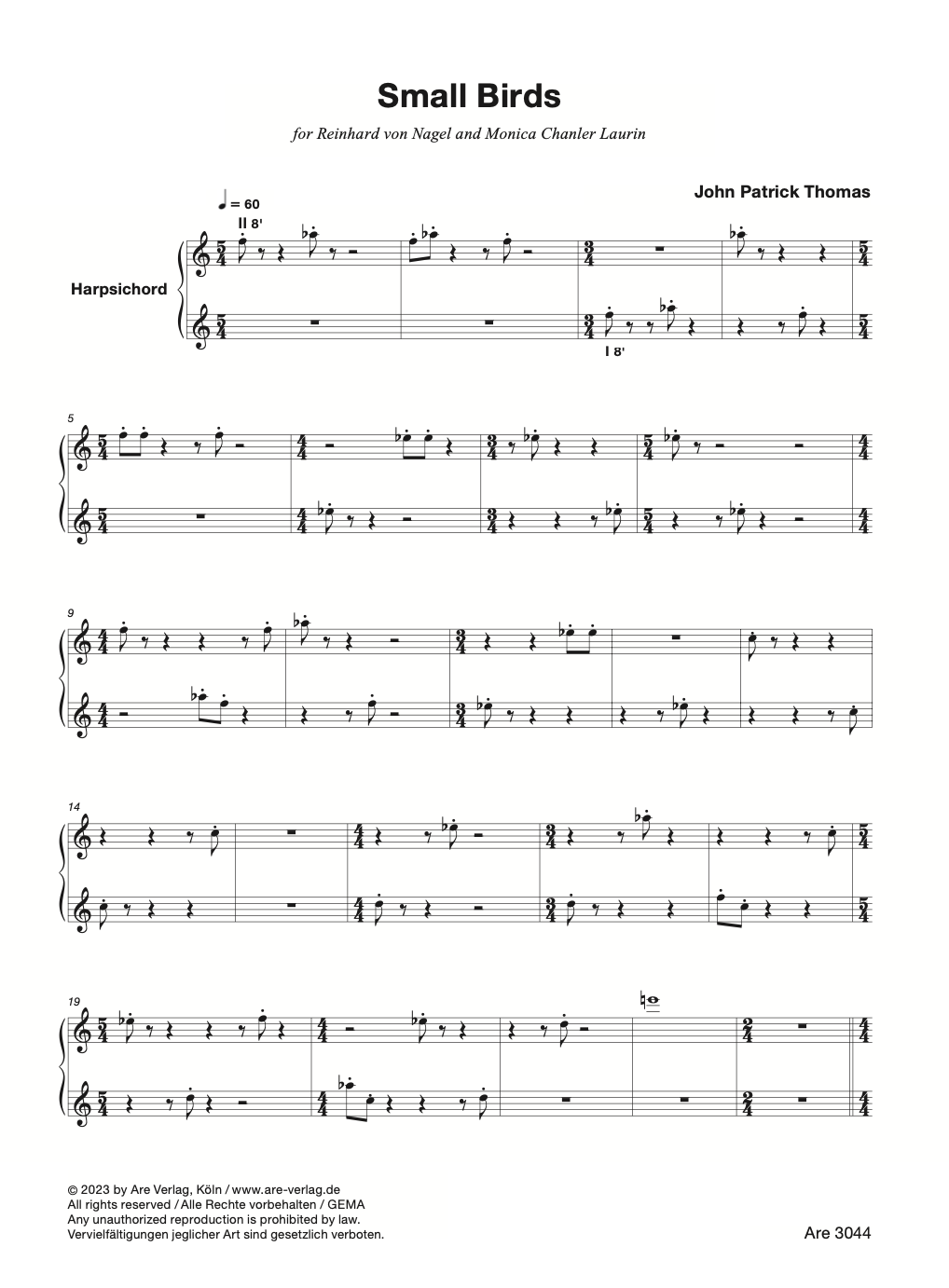Beschreibung
John Patrick Thomas
Small Birds
Elegy No. 3
Imaginary Dances
1. Hamburg Hustle
2. Slow Dancing in Karlsruhe
3. Buffalo Shuffle
4. Thun Tango
5. Berkeley Rocks
Landscape with Architecture
Introduction
Why harpsichord in this age of burgeoning techno- logical inventions? From the practical standpoint, during my career as a countertenor, I worked with a number of excellent Early Music harpsichordists who also had a keen interest in New Music. Over the years, several of these players—beginning with Alan Curtis and William Christie—liked the music I’d written for other instruments and suggested I compose something for the harpsichord. I also met a number of renowned instrument builders who encouraged me, among them William Dowd in Boston and Reinhard von Nagel in Paris.
I love the sound of classical harpsichords and am continually amazed at the variety of colors they can produce. These familiar sounds take on a special tension and vitality when we hear them in different contexts. The Ligeti pieces for harpsichord, for example, have an extraordinary effect in part because they exhibit the sonority of the instrument used by Rameau and the Couperins, but with a completely different musical language.
I think the music of our time is all the music available to us in our global culture, which gives us unprecedented access to music from earlier periods. While I have no interest in emulating historical models in my compositions, several of my pieces were conceived as companions for works from the harpsichord’s great repertoire. Of course, if I had ever had access to an electronic studio or electronic instruments, I would happily have written a great deal of music using new media and technologies. But my life has led me in another direction.
Notes on the music
Small Birds (1974) was the first real piece I wrote for harpsichord, though I had used the instrument in incidental music for a production of Goldsmith’s She Stoops to Conquer while I was in college. I wrote Small Birds to accompany related character pieces by Rameau and François Couperin. The work is dedicated to Reinhard von Nagel and Monica Chanler Laurin.
Elegy No. 3 (1995) was written in memory of a friend, the distinguished musicologist Thomas Walker. Originally conceived for a clavichord belonging to John Whitelaw, it has been played many times on the harpsichord by Arthur Haas, who has also passed it on to his students. In retrospect, I imagine this work as an interesting companion piece for Froberger’s Tombeau de M. Blancrocher.
Imaginary Dances ( 1997 ) was written for the harpsichordist Christine Daxelhofer. For many years a professor of Early Music at the Hochschule für Musik in Karlsruhe, she initiated the composition of my pieces for multiple harpsichords and players (Pages, Music for Kagel, and Millennium Music) to provide ensemble opportunities for her and her students. Among these students were Irene Müller- Glasewald and Kristian Nyquist, who have continued her commitment to New Music. Imaginary Dances draws on the tradition of 17th and 18th century harpsichord suites with stylized dances. The five movements refer to places and players that brought me into contact with the harpsichord’s great tradition.
Landscape with Architecture (1977/2023) was originally composed for a 12-string Renaissance lute (the Japanese lutenist Toyohiko Satoh played the premiere in Holland). That original version is dedicated to my friend Jürgen Hübscher, who loaned me his instrument for experimentation, while we were both appearing in a Stuttgart production of Mauricio Kagel’s theater piece Mare Nostrum. As this particular historical lute is fairly unusual, it occurred to me much later that it might be interesting to have a version for harpsichord. Kristian Nyquist helped me with the transcription; this second version is dedicated to him. The piece alternates passages based on fixed material with others that are more wild and free.
JPT, Hamburg, August 2023
Notes for performance
1. Metronome markings should be observed as closely as possible within the scope of individual interpretations.
2. Accidentals apply throughout the measures in which they appear, although cautionary markings occur as well.
3. I have used the “finger pedal” device in certain places to achieve a particularly sustained resonance. The customary term legato is used when it seems more appropriate for fingerings.
4. While I am fairly specific about tempi, pitches, registration, and articulation, I do accept interpretive choices when these seem appropriate for individual players and instruments.
Acknowledgements
Several people have already been mentioned in these notes. I’m grateful to all of them. Diane and Jan Williams play an important part in the preparation of my scores. Ann Holyoke Lehmann, Richard Rieves, and Kristian Nyquist continue to provide welcome advice and assistance.
Are 3044







